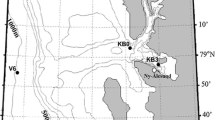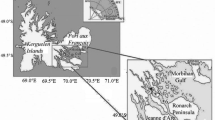Abstract
Calanus species, particularly those in high latitudes, can accumulate large oil reserves consisting predominantly of wax esters. These wax esters consist predominantly of 16:0, 20:1 (n−9) and 22:1 (n−11) fatty alcohols, mainly formed de novo by the animals from non-lipid dietary precursors, esterified with various fatty acids that are often polyunsaturated fatty acids and largely of dietary, phytoplanktonic origin. Wax ester formation is maximal in copepodite stages IV and V. The lipids are elaborated not primarily for buoyancy regulation but as a source of metabolic energy during overwintering, particularly for reproduction. Large quantities of wax esters are utilised for gonadal development when stage V copepodites mature to females. Development of stage V copepodites to males is not accompanied by wax ester utilisation but males consume large amounts of these lipids in physical activity during reproduction. The role of wax esters in the life history of calanoids is illustrated with particular reference to a comparison of Calanus finmarchicus and Metridia longa in Balsfjord, northern Norway.
Similar content being viewed by others
References
B»mstedt, U., 1979. Reproductive bioenergetics within the summer and winter generations of Euchaeta norvegica (Copepods). Mar. Biol. 54: 135–142.
B»mstedt, U. & J. B. L. Matthews, 1975. Studies on the deep-water pelagic community of Korsfjorden, western Norway. The weight and biochemical composition of Euchaeta norvegica in relation to its life cycle. In H. Barnes (ed.), Ninth Europ. Mar. Biol. Symp. Aberdeen University Press, Aberdeen: 311–327.
Ben-Amotz, B., T. G. Tomabene & W. H. Thomas, 1985. Chemical profile of selected species of microalgae with emphasis on lipids. J. Phycol. 21: 72–81.
Benson, A. A., R. F. Lee & J. C. Nevenzel, 1972. Wax esters: major marine metabolic energy sources. Biochem. Soc. Symp. 35: 175: 175–187.
Bottino, N. R. 1975. Lipid composition of two species on Antarctic krill: Euphausia superba and E. crystallorophias. Comp. Biochem. Physiol. 50B: 479–484.
Clarke, A., 1984. The lipid content and composition of some Antarctic macrozooplankton. Br. Antarct. Surv. Bull. 63: 57–70.
Falk-Petersen, S., K. S. Tande & J. R. Sargent, 1988. Polar Biol. Food pathways in relation to the lipid composition of sub-arctic zooplankton. Polar Biol. In the press.
Falk-Petersen, S., R. R. Gatten, J. R. Sargent & C. C. E. Hopkins, 1981. Ecological investigations on the zooplankton community of Balsfjorden, northern Norway. Seasonal changes in the lipid class composition of Meganyctiphanes norvegica, Thysanoessa raschii and Thysanoessa inermis. J. exp. mar. Biol. Ecol. 54: 209–224.
Gatten, R. R., E. D. S. Comer, C. C. Kilvington & J. R. Sargent, 1979. A seasonal survey of the lipids of Calanus helgolandicus Claus from the English Channel. In E. Naylor and R. G. Hartnol (eds), Cyclic phenomena in marine plants and animals. Pergamon Press, Oxford: 275–284.
Gatten, R. R., J. R. Sargent, T. E. V. Forsberg, S. C. M. O'Hara & E. D. S. Comer, 1980. On the nutrition and metabolism of zooplankton. XIV Utilization of wax esters by Calanus helgolandicus during maturation and reproduction. J. mar. biol. Ass. U.K. 60: 391–399.
Hakanson, J. L., 1984. The long and short term feeding condition in field — caught Calanus pacificus, as determined from the lipid content. Limnol. Oceanogr. 29: 794–804.
Henderson, R. J., J. R. Sargent & C. C. E. Hopkins, 1984. Changes in the content and fatty acid composition of lipid in an isolated population of the capelin Mallotus villosus during sexual maturation and spawning. Mar. Biol. 78: 255–263.
Hopkins, C. C. E. 1977. The relationship between maximal body size and clutch size, development time and egg mortality in Euchaeta norvegica (Copepods - Calanoida) from Loch Etive, Scotland. J. mar. biol. Ass. U.K. 57: 723–733.
Hopkins, C. C. E., K. S. Tande, S. Gronvik & J. R. Sargent, 1984. Ecological investigations of the zooplankton community of Balsfjorden, northern Norway: an analysis of growth and overwintering tactics in relation to niche and environment in Metridia longa (Lubbock), Calanus finmarchicus (Gunnerus), Thysanoessa inermis (Kroyer) and T. rashi (M. Sars) J. exp. mar. Biol. Ecol. 82: 77–99.
Kogeler, J. W., S. Falk-Petersen, A. Kristensen, F. Pettersen & J. Dahlen, 1987. Density and sound speed contrasts in sub-arctic zooplankton. Polar Biol. 7: 231–235.
Lee, R. F., 1974. Lipid composition of the copepod Calanus hyperboreus from the Arctic ocean. Changes with depth and season. Mar. Biol. 26: 313–318.
Lee, R. F., 1975. Lipids of arctic zooplankton. Comp. Biochem. Physiol. 51B: 263–266.
Lee, R. F. & J. Hirota, 1973. Wax esters in tropical zooplankton and nekton and the geographical distribution of wax esters in marine copepods. Limnol. Oceanogr. 18: 227–239.
Lee, R. F. & A. T. Barnes, 1975. Lipids in the mesopelagic copepod Gaussia princeps. Wax ester utilization during starvation. Comp. Biochem. Physiol. 50B: 1–4.
Lee, R. F., J. Hirota, J. Barnett & A. M. Barnett, 1971. Distribution and importance of wax esters in marine copepods and other zooplankton. Deep Sea Res. 18: 1147–1165.
Lee, R. F., J. C. Nevenzel & G. -A. Paffenhöfer, 1972. The presence of wax esters in marine planktonic copepods. Naturwissenschaften 59: 406–411.
Lee, R. F., J. C. Nevenzel & A. G. Lewis, 1974. Lipid changes during life cycle of marine copepod Euchaeta japonica Marukawa. Lipids 9: 891–898.
Lewis, R. W., 1970. The densities of three classes of marine lipids in relation to their possible role as hydrostatic agents. Lipids 5: 151–153.
Marshall, S. M. & A. P. Orr, 1955. The Biology of a Marine Copepod. Oliver and Boyd, Edinburgh: 188 pp.
McLaren, I. A. & C. J. Corkett, 1978. Unusual genetic variation in body size, development times, oil storage and survivorship in the marine copepod Pseudocalanus. Biol. Bull. 155: 347–359.
Pascal, J. C. & R. G. Ackman, 1976. Long chain monoethylenic alcohol and acid isomers in lipids of copepods and capelin. Chem. Phys. Lipids 16: 219–223.
Sargent, J. R., 1976. The structure, function and metabolism of lipids in marine organisms. In D. C. Malins & J. R. Sargent (eds), Biochemical and Biophysical Perspectives in Marine Biology. Academic Press, London: 3: 150–212.
Sargent, J. R., 1978. Marine wax esters, Sci. Progress 65: 437–458.
Sargent, J. R. & S. Falk-Petersen, 1981. Ecological investigations on the zooplankton community in Balsfjorden, northern Norway: Lipids and fatty acids in Meganyctiphanes norvegica, Thysanoessa raschii and Thysanoessa inermis. Mar. Biol. 62: 131–137.
Sargent, J. R. & R. J. Henderson, 1986. Lipids. In E. D. S. Corner & S. C. M. O'Hara (eds), The Biological Chemistry of Marine Copepods. Clarendon Press, Oxford: 59–164.
Sargent, J. R., R. F. Lee & J. C. Nevenzel, 1976. Marine waxes. In P. Kolattukudy (ed.), Chemistry and Biochemistry of Natural Waxes. Elsevier, Amsterdam: 50–91.
Sargent, J. R., R. R. Gatten, E. D. S. Comer, & C. C. Kilvington, 1977. On the nutrition and metabolism of zooplankton. Lipids in Calanus helgolandicus grazing Biddulphia sinensis. J. mar. biol. Ass. U.K. 57: 525–533.
Sargent, J. R., H. C. Eilertsen, S. Falk-Petersen & J. P. Taasen, 1985. Carbon assimilation and lipid production in phytoplankton in northern Norwegian fjords. Mar. Biol. 85: 109–116.
Tande, K. S. & R. J. Henderson, 1988. Lipid composition of copepodite stages and adult females of Calanus glacialis from arctic waters of the Barents Sea. Polar Biol. In press.
Yayanos, A. A., A. A. Benson & J. C. Nevenzel, 1978. The pressure-volume-temperature (PVT) properties of a lipid mixture from a marine copepod, Calanus plumchrus: implications for buoyancy and sound scattering. Deep Sea Res. 25: 257–268.
Volkman, J. K., G. Eglinton & E. D. S. Corner, 1980. Sterols and fatty acids of the marine diatom Biddulphia sinensis. Phytochem. 19: 1809–1813.
Author information
Authors and Affiliations
Rights and permissions
About this article
Cite this article
Sargent, J.R., Falk-Petersen, S. The lipid biochemistry of calanoid copepods. Hydrobiologia 167, 101–114 (1988). https://doi.org/10.1007/BF00026297
Issue Date:
DOI: https://doi.org/10.1007/BF00026297




